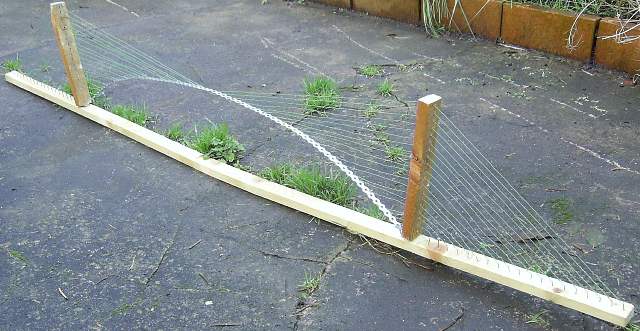Cable-stayed/suspension hybrid bridges
This page is a FAQ about cable-stayed/suspension hybrid bridges.

Cable-stayed/suspension hybrid - model
|
Cable-stayed/suspension hybrid - FAQ
What desirable aspects of the cable-stayed bridge
have been inherited?
- The weight is borne further down the towers - meaning their
upper parts can be constructed more cheaply;
- The towers are relatively short, for similar stability
characteristics;
- The cables are much thinner than with a suspension
bridge - hopefully meaning that no spinning in place
of the cables is necessary;
- The ground anchor can be spread out along a line if
required - allowing for the option of using cheaper
machinery for more days;
- All the cables can be conveniently replaced if necessary
- making maintenance easier.
What undesirable aspects of the cable-stayed bridge
remain?
- The cables are prone to oscillation with low, heavy
notes - and need to be restrained with additional damping
cables;
- The cables have a substantial surface area - and are
relatively vulnerable to corrosion.
What desirable aspects of the suspension bridge
have been inherited?
- The pattern scales well to cover large spans;
- No additional trusswork in the roadway is necessarily required;
What undesirable aspects of the suspension bridge
remain?
- Large volumes of cable are required - this cable has a
fair surface area, and some of it will be exposed to
corrosion.
- Installing the cables is not as hard as with a suspension
bridge, but it is harder than with a cable-stayed bridge.
- Large ground anchors are required at either end of the bridge.
- The roadway typically curves upwards in the middle: this
can present complications in multi-span structures.
What advantages are there - over a suspension bridge?
While both types of bridge require ground anchoring, the
demands made by the hybrid pattern are less demanding -
since it is only the roadway which needs anchoring - and
that can be done practically anywhere - and the ground
anchor can be easily distributed over a large area.
The piers need not be so high.
The piers need not carry the weight of the bridge
entirely at their highest points.
Replacing individual cables is possible - while it is
difficult to replace the cables after corrosion in the
main catenary cables of a suspension bridge.
In most cases, this type of bridge can be expected
to offer performance superior to a classical suspension
bridge.
What advantages are there - over a cable-stayed bridge?
Since the roadway is not forced to sustain large compression
forces, it can be made lighter and cheaper than in a
classical cable-stayed bridge.
These bridges should scale to cover large spans
much better than a normal cable-stayed bridge would.
In most cases, this type of bridge can be expected
to offer performance superior to a classical cable-stayed bridge.
Cable-stayed/suspension hybrid bridges
This page is a FAQ about cable-stayed/suspension hybrid bridges.
|